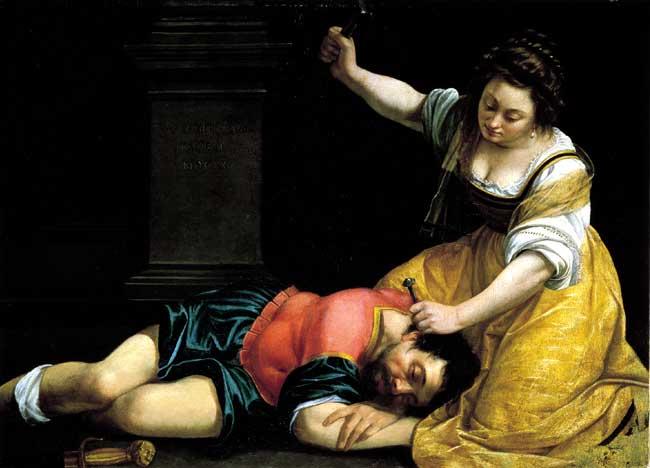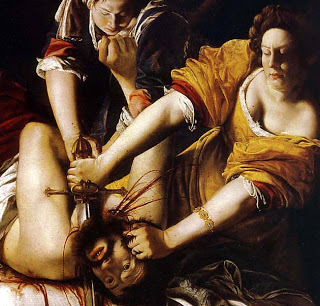The Holy Father made a good point in his Angelus Address today.
He said:
Elizabeth, welcoming Mary, recognizes that the promise of God to humanity is being fulfilled and she exclaims, “Blessed art thou among women, and blessed is the fruit of thy womb. And whence is this to me, that the mother of my Lord should come to me?”. The expression “Blessed art thou among women” refers in the Old Testament to Jael (or Yael or Jahel – Judges 5,24) and to Judith (Judith 13,1), two warrior women who strive to save Israel. Now, on the other hand, it refers to Mary, a peaceful young girl who is about to bear the Savior of the world. So too the leap of joy of John (cf Luke 1,44) recalls the dance that King David did when he accompanied the Ark of the Covenant into Jerusalem (cf 1 Chronicles 15.29). The Ark, which contained the tablets of the Law, manna and the rod of Aaron (cf Hebrews 9,4), was a sign of the presence of God in the midst of His People. John, about to be born, leaps in joy before Mary, the Ark of the New Covenant, who bears in her womb Jesus, the Son of God made man.
Here is Artemesia’s Jael and Sisera:
As in her painting of Judith, you can see the cool, peaceful way in which she hammers the spike through the enemy’s head as he sleeps. It is always interesting to see Artemesia’s portrayal of scenes more commonly painted by men.
A detail from her Judith. Workman-like, getting the job done:




































I have never forgotten my first reading of the book of Judith. Exciting stuff! The Protestants don’t know what they are missing.
Artemisia Gentileschi is quite an odd bird, for a lot of reasons. Her treatment of violent themes among them. I like her portraits – surprising calm and perceptive, given the excessively dramatic “Judith”.
Artemisia Gentileschi’s work reminds me a bit of Caravaggio.
Judith and Jael struck the enemy while he was asleep. It’s interesting that Mary bears Jesus while the world is asleep.
What’s always struck me about Artemisia’s interpretation of Judith is the teamwork between Judith and her maid. Take a closer look and you’ll see what I mean.
Also, have you noticed how Judith is trying very hard not to get blood on her dress?
Definitely influenced by Caravaggio – he was all the rage at the time.
She’s not going to succeed in keeping that blood off her dress — I think she’s just flinching thinking about how hard it is to get blood out of yellow satin . . . but in the earlier version (a more riveting close-up, in my opinion) she’s wearing a blue dress and flinching just the same, even though there’s no arterial blood flying around.
Like I said, she’s an odd bird.
Ahh Artemisia …
It’s always wonderful to see one of her paintings here http://www.dia.org/object-info/0573dd3e-1079-4ce3-8262-78b0e1e68331.aspx when I visit the DIA.
Well, it looks like Jael usually does the cooking and animal-killing herself for the tent, whereas Judith had been living as a contemplative widow and had a maid to do that stuff for her. Not that she can’t do it, of course.
My mother had happy childhood memories of learning how to kill chickens in various ways, which she shared with me as a child. (The memories, not the chicken-killing. We don’t have any live chickens, unlike Mammaw Mummaw.)
Oh I had a shock scanning your page!
I thought I caught a mention of Mary; and I thought, oh nice, Father Z is writing about the nativity, and he has–as always, nice artwork. So glancing down, I think, how nice, an image of our Lady with Saint Joseph…he’s sleeping in her lap, how quaint…er…what’s Mary doing to Joseph???
Egad!
I must read things more closely…
[Surprise!]
“fruit of thy womb” always hits me in the Pro-Life cause…….
Pingback: Catholic Bandita » Blog Archive » Advent Tweets From Catholic Priests
Aside from the Liturgy of the Hours, and attending Mass, I really don’t read the scriptures too often – I prefer spiritual writings by the saints or their biographies. Currently, my Lay Carmelite Community is reading and studying “Story of a Soul” by St. Therese. But recently, out of the blue, I was inspired either by the Holy Spirit or my Guardian Angel to ask the Lord for a passage in the bible – purely random – and was led to Judith. Now, I’ve been very concern about this country especially after the “re-election” of Obama and perhaps the Lord was reassuring me that if persecution does come, Judith, who prefigures Our Lady, will ultimately deliver us. God’s people in Judith’s time were on the point of extermination but she save them. Will Our Lady do the same for us?
Mass is the scriptures
On a little tangent here: Artemisia’s experience as a rape victim — and one who was tortured by the authorities so they could make sure that she wasn’t leveling a false accusation — may have influenced her depictions of Jael and Judith, as it apparently influenced her depiction of Susanna. (In her painting of Susanna, she reportedly gave the two wicked elders the faces of her rapist and her own father, whom she blamed for failing to stand up for her when she went public with what had happened to her.) She probably found great solace in the stories of these biblical heroines.
The feminists of course have had a field day with that episode.
The story about painting her father into “Susanna and the Elders” is probably not true, for several reasons – 1. it was one of her first paintings and her father probably assisted her; 2. Orazio actually backed her up and assisted in the prosecution, so no motive for her to resent him; 3. Artemisia maintained cordial relations with her father for the remainder of his life. And the older man in the painting doesn’t resemble Van Dyck’s portrait of Orazio (but Holofernes and Sisera do resemble the rapist).
But everybody seems to have been very practical-minded about the situation, once they got a conviction her reputation was re-established and she continued in her career. It seems that she acknowledged it, worked it out through her art, and moved on with her life. Kudos to her for Dealing With It.
Aha! Thanks for setting that straight.
No worries. History is a hobby of mine, especially where it intersects art.
She was an odd bird, but a good one. Not in the first rank, her work is very uneven – but a competent painter with flashes of real brilliance.
Always nice to see a woman succeed by talent, hard work, and application rather than whining about the patriarchy . . . :-)
And you do it well, AAM. Merry Christmas!